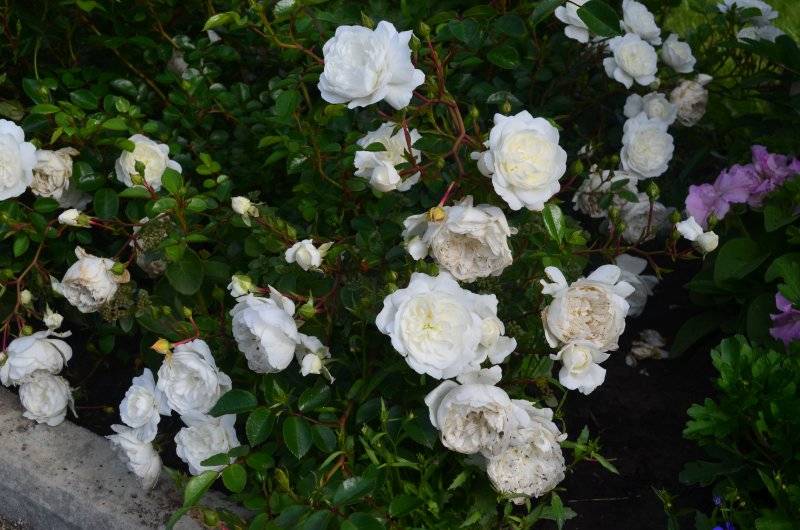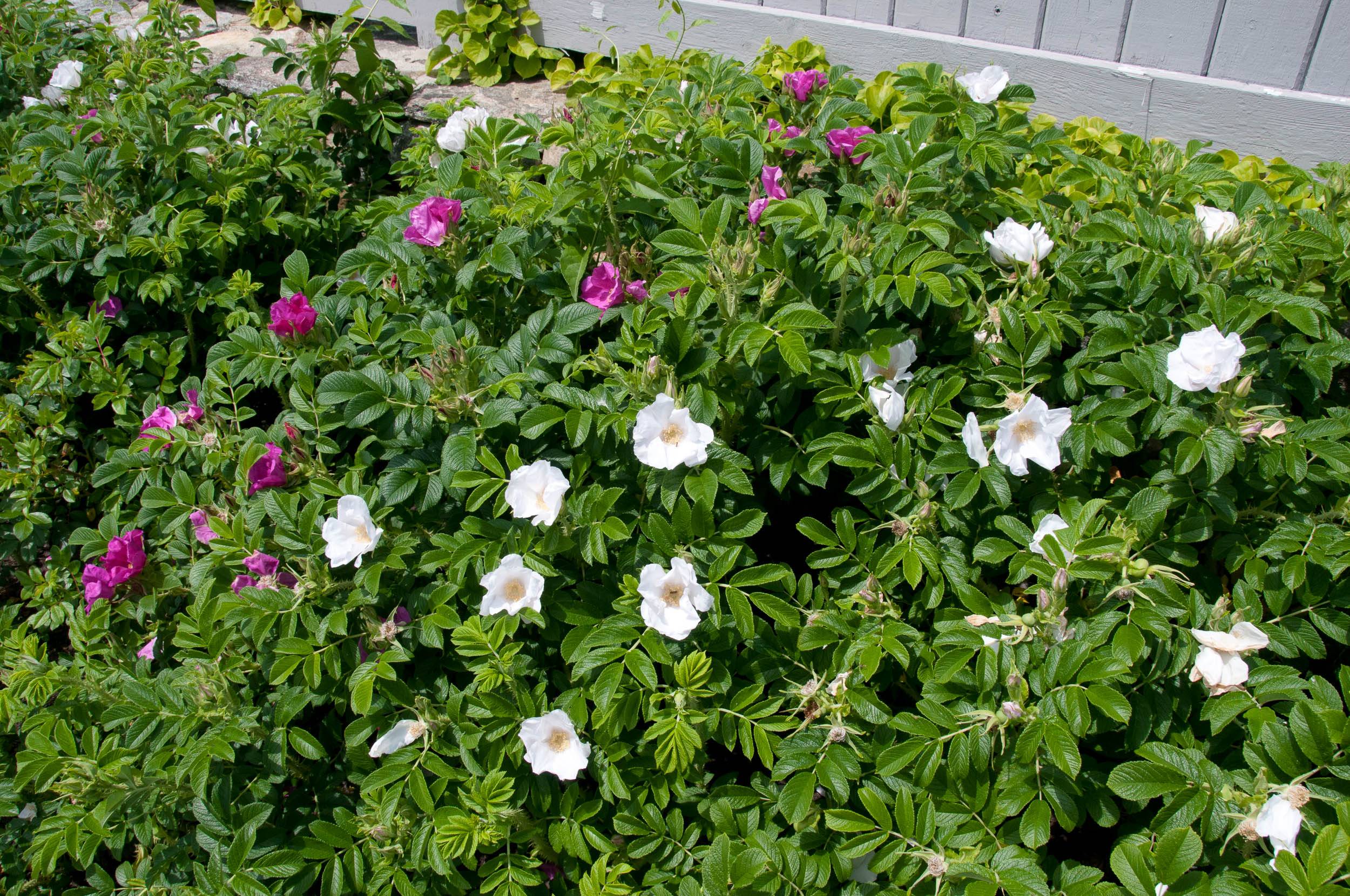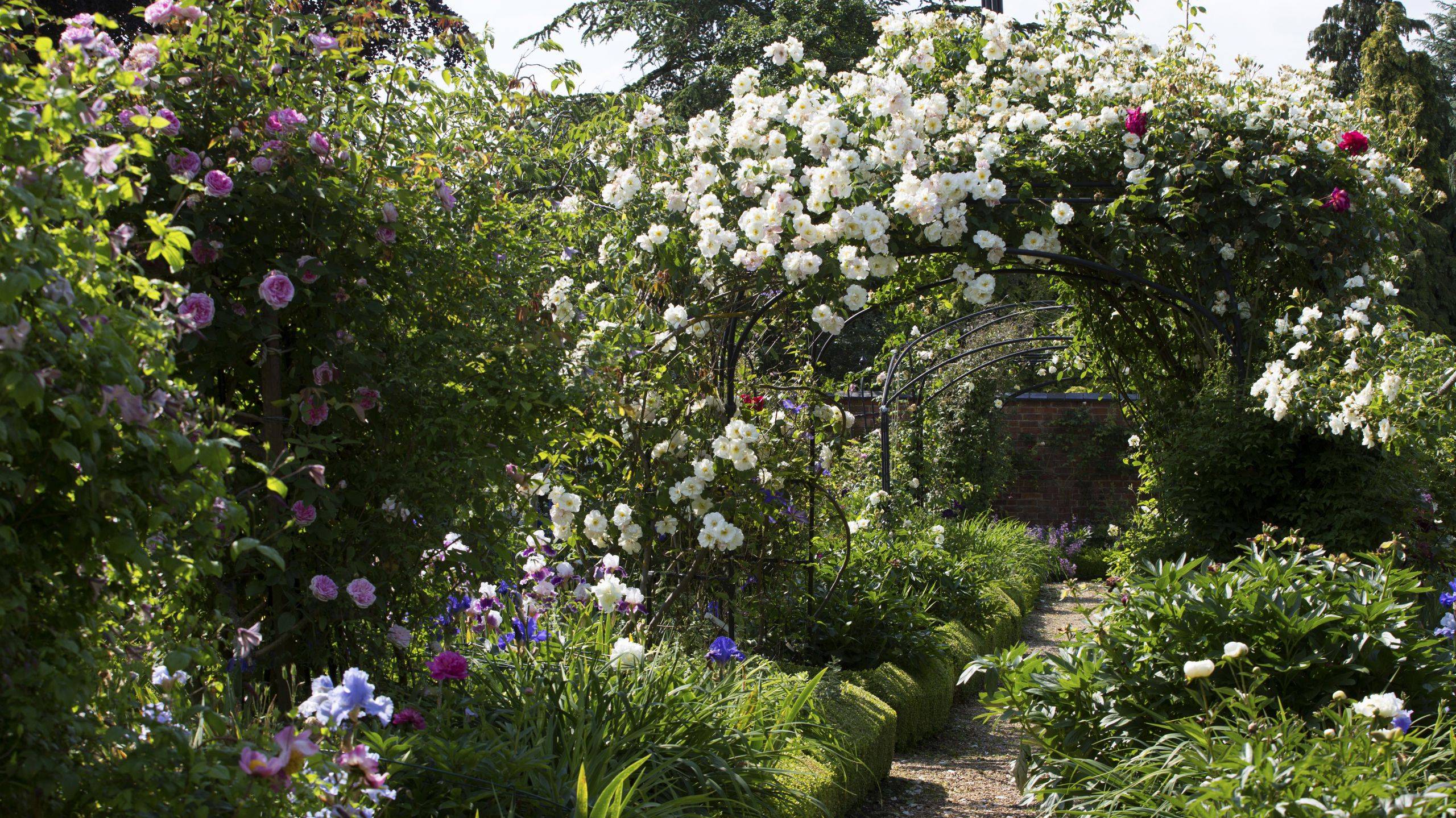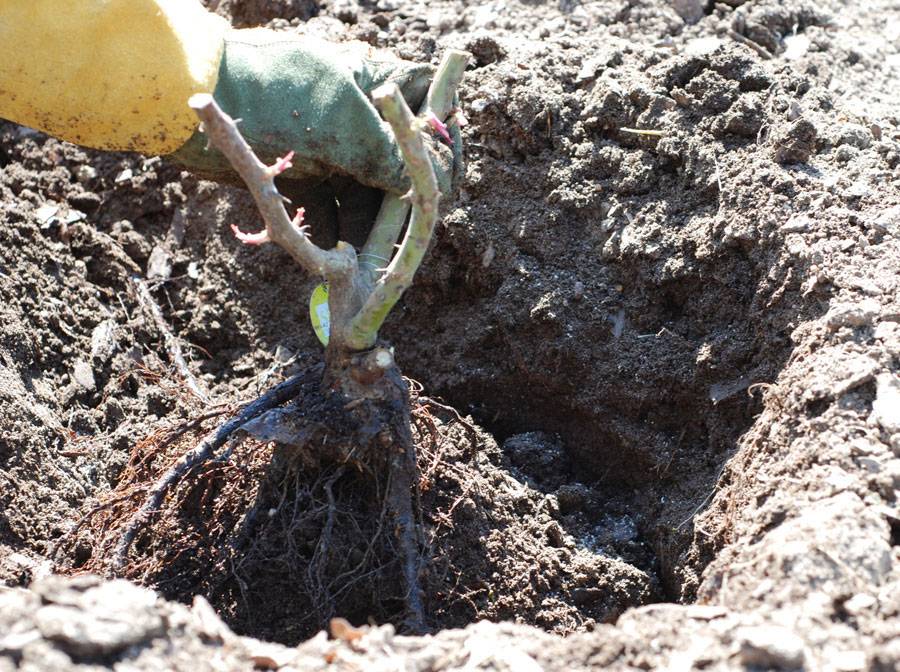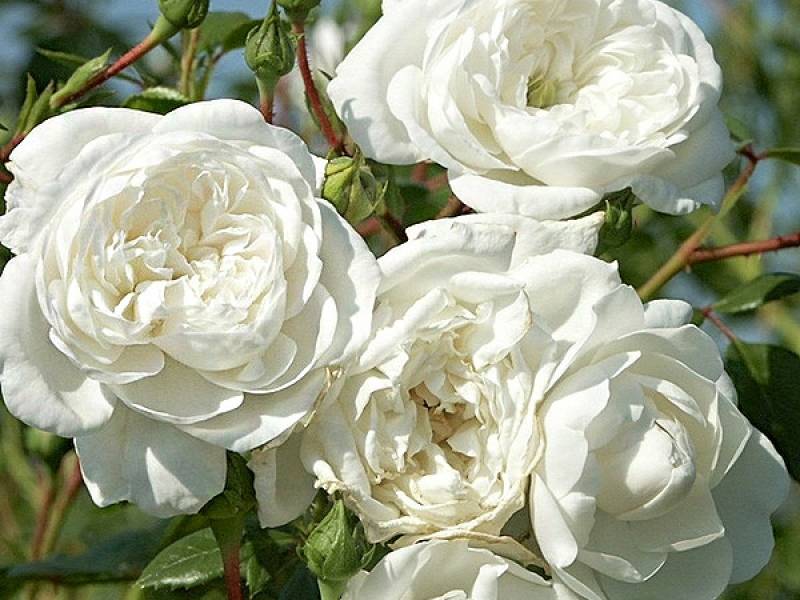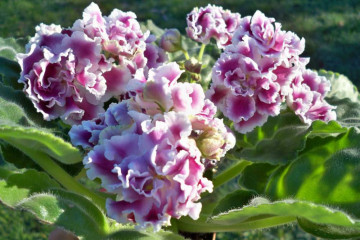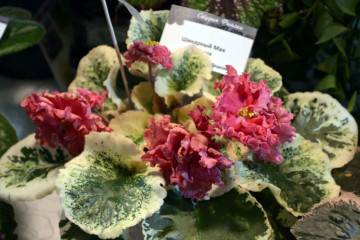Rose Swany - description and characteristics of the variety
Content:
Rose Swanee is one of the finest representatives of ground cover roses. She has an amazing ability to creep and cover quite large areas of the flower bed. Of course, in order to get the maximum result, you will have to work hard and provide the plant with proper care. This variety is loved by both ordinary flower growers and landscape designers.
Rose Swany (Swanee, Swanee, MEIburenac) - what is this variety, history of creation
Rose Swany is pronounced differently in Russian - Swany, Savoni, Swany, Swany rose. It begins its history from the Japanese wrinkled rose, which grows mostly in Asian countries. This is a flower that occupies vast areas in the wild. For this ability, ground cover varieties of roses are also called carpet roses. Swanee rose for the first time appeared in 1977 in France, thanks to the efforts of breeders of the Meilland company.
Brief description, characteristic
Botanical description of the Swanee variety:
- life form - lush groundcover with a lot of leaves;
- maximum height 70 cm, diameter 2 m;
- leaves are small, glossy, green;
- flowers are densely double, the number of petals in one flower is up to 40 pieces;
- the diameter of the flower is 5-6 cm, the color is snow-white, sometimes with a pink tint in the middle;
- flowers are collected in umbrella-shaped inflorescences; in adult plants, the inflorescence can consist of 20 buds.
Advantages and disadvantages of the variety
| Benefits | disadvantages |
| high decorative qualities; | problems in preparing for the winter period; |
| long and abundant flowering, characteristic of all floribundas; | the need for careful care. |
| delicate, subtle, calm, pleasant aroma; | |
| tolerates winter frosts well; | |
| high immunity. |
Use in landscape design
Like all carpet varieties, Swanee is actively used by landscape designers. Most often they are used to create blooming areas against a green lawn background.
There is an option for growing in pots. In this case, chic flowing cascades are obtained, which look spectacular next to any plants. This rose variety looks great on slopes that look incredibly sophisticated when fully covered with this snow-white fluffy carpet.
They are also suitable for growing on alpine slides. They are used as hedges, tying them to trellises, using them to separate flower beds, parts of the garden, serve as an excellent border located around the flower garden, especially the one where bright flowers grow. They are also wonderful for decorating gazebos.
Growing a flower, how to plant it in open ground
In order to grow any rose, you need to take into account a number of requirements and conditions, otherwise nothing will work. No wonder the plant is called the queen of flowers.
In what form is the planting carried out (by seeds, seedlings, etc.)
Seed planting of this rose in open ground is not possible. The best option is ready-made seedlings. If it is not possible to purchase planting material, and the climate is mild enough, you can try to plant cuttings.
What time is the boarding
In areas where the climate is mild and the winters are not too harsh, roses are planted in autumn (September - October). Where weather conditions are harsh, spring planting is recommended. It is carried out when the ground is already well warmed up and the threat of frost has passed (late April - early May).
Location selection
For planting Swaney roses, choose a well-lit, sunny place, protected from gusty winds and drafts. The southeast or west are considered the best sides.
How to prepare the soil and flower for planting
The soil is prepared in advance for planting Swanee - 6-12 months before the planned date. The best soil option is black soil. A slightly acidic soil with a pH of 6.0-6.5 is optimal. This indicator can be easily edited - if the soil is too acidic, ash or lime is introduced, and with a substrate with a low pH level, manure (preferably cow) or peat is introduced.
Coarse river sand is added to heavy clay soil. And for too loose light soil, it is worth laying clay at the bottom of the planting pit. Only with sufficient looseness will the flower actively grow, develop and bloom luxuriantly.
The depth of the planting hole should not be less than half a meter. It all depends on the level of development of the seedling and its size. If you plan to plant several roses at once, it is wiser to dig a deep trench.
Planting procedure step by step
To prepare a seedling, you need to cut the shoots, leaving 3-5 buds on each. Before planting a flower, you need to carefully examine its root system for damage. They are removed by sprinkling the cuts with crushed charcoal. The roots of the Swanee rose are gradually covered with loose prepared soil, not allowing voids to form.
The planting process is simple, the main thing is to follow a certain sequence of actions:
- The roots of the seedling are spread out. All kidneys below the site of the vaccination are removed. The roots are trimmed and dipped in the clay mixture.
- At the bottom of the pit, a sandy layer approximately 10 cm wide (for clay soil) or clay (for too loose soil) is poured.
- A couple of compost buckets are filled in.
- The top layer of soil is mixed with 1-2 buckets of compost, poured into the pit and a small mound is formed in which a hole is made.
- The roots of the seedling, previously straightened, are lowered into this hole. So that the grafting site remains slightly below the soil level. The soil is lightly compacted by hand.
After planting, water the seedling abundantly. Cover the soil with compost or humus. Thanks to a layer of mulch, the root system of the rose will be protected from cold weather and temperature changes.
Plant care
In order to properly care for this variety of roses, you need to make some effort.
Watering rules and humidity
Watering is carried out in the morning or in the evening. Do not water during the day in sunny weather to avoid burns on the leaves and stems of the plant. In the first year of life, the bushes are watered 2 times a week, in the future it will be enough once.More frequent watering is possible during dry periods and vice versa.
Top dressing and soil quality
The soil for the Swanee rose must be nutritious, air and moisture permeable. Top dressing is carried out infrequently, it is enough to apply fertilizer 3 times per season. In the spring, complex mineral fertilizers are applied, in subsequent times only potash and phosphorus fertilizers. During the budding and flowering period, the main thing is to avoid nitrogenous fertilizers.
Pruning and replanting
For ground cover roses, to which Swanee belongs, pruning is practically not required, this greatly facilitates the life of a florist. The main procedure for sanitary pruning is carried out in the fall, when weakened, dried and damaged shoots are simply removed.
Anti-aging pruning is performed every 5 years. You will also need to remove already wilted flowers to stimulate the growth of new buds.
Throughout the season, after the spring planting, it is better to remove all emerging buds and avoid flowering, so that the rose gains strength, and the development of new shoots, on which many flowers will form next year, has become a priority.
Features of wintering a flower
Rose Swanee needs shelter for the winter, especially young specimens. A natural material (spruce paws, fallen leaves) or a special garden cover can serve as a shelter.
But if the climate is warm and mild in winter, the plant may not be covered at all. However, it is worth remembering that under unpleasant weather conditions for a flower, it can be affected by rot, spotting or powdery mildew, to which Swany has a rather low resistance.
Blooming rose
The flowering of this rose variety is beautiful, it is mesmerizing. Especially when several bushes are planted nearby, and they already occupy a large area. Snow-white flowers look very impressive on a green background. A rose can also be tied to a stem, and with proper care, a stem tree can be grown from it.
A period of activity and rest
The flowering period begins in June, the last buds bloom in the middle of autumn.
Care during and after flowering
During flowering, it is worth feeding the rose with potash and phosphorus fertilizers in order to provoke the most lush flowers. Also at this time, it is necessary to cut off the fading buds and inflorescences in a timely manner, so that new ones appear in their place.
What to do if it does not bloom, possible reasons
If the rose is not blooming, it may not be well cared for. First of all, this concerns the choice of the place, it should be bright and well lit.
The lack of flowering can be triggered by too lush green growth. The soil may be over nitrogen or the wrong soil is selected.
A difficult wintering is another reason for the lack of bud laying. Perhaps the plant needs serious recovery after the winter cold. And another reason is the occurrence of diseases or damage by insect pests.
Flower propagation
The most common ways to propagate the Swane rose are by cuttings and layering. Seed reproduction in this case does not make sense due to the fact that it is a hybrid, which means that the daughter individuals will not inherit the properties of the mother.
Layers
Creeping ground cover roses, to which Swanee belongs, can simply be propagated in this way. It is enough to take a shoot, press it to the ground, and it will take root by itself, without additional intervention. Later it is sprinkled with soil and watered thoroughly.
By cuttings
At the beginning of autumn, planting material is prepared - ripe shoots, the thickness of which is equal to the thickness of a pencil. The minimum number of internodes on them is 3.
A cut is made under the lower bud, break off all the thorns on the branch and cut off the lower leaves. Within 2 hours they are soaked in a growth stimulator, after which they are planted in a shaded area in small holes 15 cm deep. There should be sand in the holes. The twig is placed there about 1/3. The soil is compacted and watered.
Diseases, pests and ways to control them
Rose Swoney has moderate immunity to most pests and diseases.
To prevent diseases, it is enough to follow the rules of care. If damage is found, it is worth removing these parts of the plant and treating it with a suitable fungicide.
Pests, such as aphids, can get on the rose from neighboring plants. Some of them will have to be collected and destroyed by hand, others only with the help of an insecticide.
Rosa Swanee is a wonderful, delicate, original variety. This groundcover rose looks great both in a single copy and when planted on a large scale. Observing the basic rules of care, you can grow chic, dazzling white flowers on your site, which will cause the most aesthetic pleasure.
